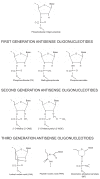Advances in antisense oligonucleotide development for target identification, validation, and as novel therapeutics
- PMID: 19787090
- PMCID: PMC2733095
- DOI: 10.4137/grsb.s418
Advances in antisense oligonucleotide development for target identification, validation, and as novel therapeutics
Abstract
Antisense oligonucleotides (As-ODNs) are single stranded, synthetically prepared strands of deoxynucleotide sequences, usually 18-21 nucleotides in length, complementary to the mRNA sequence of the target gene. As-ODNs are able to selectively bind cognate mRNA sequences by sequence-specific hybridization. This results in cleavage or disablement of the mRNA and, thus, inhibits the expression of the target gene. The specificity of the As approach is based on the probability that, in the human genome, any sequence longer than a minimal number of nucleotides (nt), 13 for RNA and 17 for DNA, normally occurs only once. The potential applications of As-ODNs are numerous because mRNA is ubiquitous and is more accessible to manipulation than DNA. With the publication of the human genome sequence, it has become theoretically possible to inhibit mRNA of almost any gene by As-ODNs, in order to get a better understanding of gene function, investigate its role in disease pathology and to study novel therapeutic targets for the diseases caused by dysregulated gene expression. The conceptual simplicity, the availability of gene sequence information from the human genome, the inexpensive availability of synthetic oligonucleotides and the possibility of rational drug design makes As-ODNs powerful tools for target identification, validation and therapeutic intervention. In this review we discuss the latest developments in antisense oligonucleotide design, delivery, pharmacokinetics and potential side effects, as well as its uses in target identification and validation, and finally focus on the current developments of antisense oligonucleotides in therapeutic intervention in various diseases.
Figures


References
-
- Zhang YC, Taylor MM, Samson WK, Phillips MI. Antisense Inhibition. In: Phillips MI, editor. Antisense Therapeutics. 2nd ed. New Jersey: Humana Press; 2005.
-
- Dias N, Stein CA. Antisense oligonucleotides: basic concepts and mechanisms. Mol. Cancer Ther. 2002;1(5):347–55. - PubMed
-
- Vidal L, et al. Making sense of antisense. Eur. J. Cancer. 2005;41(18):2812–8. - PubMed
Grants and funding
LinkOut - more resources
Full Text Sources
Other Literature Sources
Research Materials

